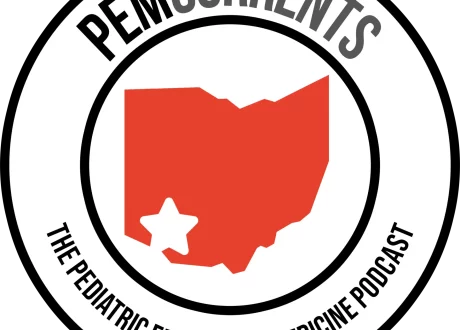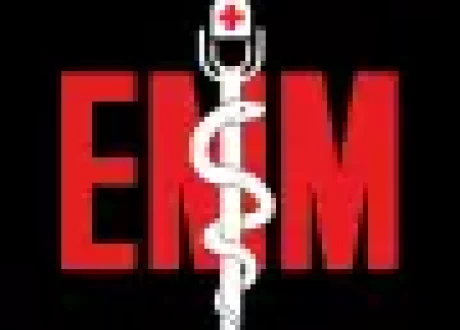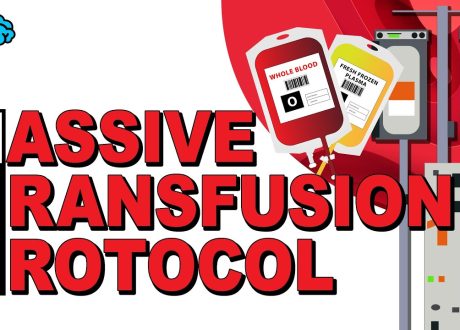Podcast: Play in new window | Download
Reference: Ramesh S, Ayyan SM, Rath DP, Sadanandan DM. Efficacy and safety of ultrasound-guided erector spinae plane block compared to sham procedure in adult patients with rib fractures presenting to the emergency department: A randomized controlled trial. AEM April 2024
Date: April 19, 2024
Guest Skeptic: Dr. Suchismita Datta. She is an Assistant Professor and Director of Research in the Department of Emergency Medicine at the NYU Grossman Long Island Hospital Campus.
Case: You are doing great things and helping many patients during your shift in the emergency department (ED) when you hear a trauma alert being called overheard. You walk over to the trauma room, and you see a healthy-looking 52-year-old male complaining of chest trauma after being involved in a motor vehicle collision before arrival. His imaging shows mildly displaced rib fractures of ribs four through seven. He is stable but complaining of pain despite initial IV acetaminophen and ketorolac. You offer him some opioids which he says makes him throw up. He’s been texting with his daughter who is an emergency medicine ultrasound fellow, and she mentioned something about using the ultrasound to inject something to decrease his pain.
Background: We have covered rib fractures once before on the Skeptics’ Guide to Emergency Medicine. This was on SGEM#324 looking at using spirometry to guide discharging older patients with rib fractures. The evidence was not robust enough back in 2021 to confidently use this potential tool.
We know that rib fractures are associated with an increased risk of morbidity and mortality – specifically related to hypoventilation-related complications [1]. These risks are particularly higher in the elderly [2].
A clinical decision tool called the STUMBL score was derived and validated by Battle et al in 2014 [3]. It risks stratified older patients with blunt trauma. An attempt was made to externally validate this tool in New Zealand by Murkerji et al 2021 [4]. It did not perform as well which is not unusual for a clinical decision instrument [5].
Rib fractures can cause lung splinting and therefore, pain management is a very important part of the management of rib fractures. In addition to coming with a litany of undesired systemic side effects such as a depressed level of consciousness and decreased respiratory drive, opioid pain medications are also short-acting and require frequent redosing.
With the 2014 CDC declaration that prescription drug overdose is one of the five top health threats, there has been a movement away from opioids as the mainstay of pain management for rib fractures [6]. There have been some studies that looked at the efficacy of alternative pain management strategies, but very few have looked at the efficacy or safety of ultrasound-guided erector spinae plane block.
CLINICAL QUESTION: HOW EFFECTIVE AND SAFE IS AN ULTRASOUND-GUIDED ERECTOR SPINAE PLANE BLOCK IN PATIENTS WITH RIB FRACTURES?
Reference: Ramesh S, Ayyan SM, Rath DP, Sadanandan DM. Efficacy and safety of ultrasound-guided erector spinae plane block compared to sham procedure in adult patients with rib fractures presenting to the emergency department: A randomized controlled trial. AEM April 2024
- Population: Adult patients with confirmed rib fractures and a numeric rating score (NRS) greater than 4, despite routine analgesia.
- Exclusions: Allergies to specific medications, penetrating thoracic trauma, pregnancy, infection or laceration at the injection site, specific health conditions (e.g., systolic BP < 100 mm Hg, subcutaneous emphysema at the block site), chronic pain, chronic analgesic use, substance abuse, immediate surgical need, or inability to give consent.
- Intervention: Ultrasound-guided erector spinae plane block (ESPB) using a high-frequency linear array transducer. The procedure targeted the transverse process corresponding to the fractured rib, where 0.5% bupivacaine was injected after confirming needle placement with saline.
- Comparison: A sham procedure involved similar preparations without actual needle insertion or injection.
- Outcome:
- Primary Outcome: The reduction in pain intensity, was measured using the 11-point NRS at six time points over 12 hours.
- Secondary Outcomes: The amount of rescue analgesia in morphine equivalents and the occurrence of adverse events.
- Type of Study: Randomized control trial, prospective, interventional
This is an SGEM Hot Off the Press episode, and it is our pleasure to introduce Dr. Manu Ayyan. He is an Associate Professor at Jawaharlal Institute of Post-Graduate Medical Education and Research (JIPMER), Puducherry, India. Dr. Ayyan is a nationally recognized educator and recipient of the 2017 INDUS-EM Emergency Medicine Leadership Award.
Authors’ Conclusions: “Ultrasound-guided ESPB resulted in significantly reduced pain intensity over the study period, reduced amount of rescue analgesia, and had no discernible difference in adverse events when compared with a sham.”
 Quality Checklist for Randomized Clinical Trials:
Quality Checklist for Randomized Clinical Trials:
- The study population included or focused on those in the emergency department. Yes
- The patients were adequately randomized. Yes
- The randomization process was concealed. Yes
- The patients were analyzed in the groups to which they were randomized. Yes
- The study patients were recruited consecutively (i.e. no selection bias) Yes
- The patients in both groups were similar with respect to prognostic factors. Yes
- All participants (patients, clinicians, and outcome assessors) were unaware of group allocation. Yes, No and Yes
- All groups were treated equally except for the intervention. Yes and No
- Follow-up was complete (i.e. at least 80% for both groups). Yes
- All patient-important outcomes were considered. Unsure
- The treatment effect was large enough and precise enough to be clinically significant. Yes and No
- Financial conflicts of interest. None
Results: A total of 46 patients were included in this trial. The mean age was 50.5 years, 87% male and 61% due to road traffic accidents.
KEY RESULTS: PAIN INTENSITY DURING THE STUDY PERIOD WAS SIGNIFICANTLY LOWER IN THE ESPB GROUP IN THE FIRST TWO HOURS, BOTH DURING REST AND DEEP INSPIRATION.
- Primary Outcome: For pain intensity: Statistically significant reduction in pain was noted at 30, 60 and 120 minutes both during rest and deep inspiration but not at 360 and 720 minutes.

- Secondary Outcomes:
- Median (IQE) rescue analgesia dose as measured in morphine equivalents, was 10 (2.5) in the ESPB group and 20 (5) in the placebo group. There was a statistically significant reduction in the rescue analgesia requirement in the ESPB group.
- There was no statistically significant difference in the occurrence of adverse events among the two groups and no serious adverse events in either group.

Listen to the SGEM podcast to hear Manu’s answer to our five nerdy questions.
1. Single Centre: This was a single-centre trial done in India. Do you think it has external validity outside your academic site or even in other countries?
2. Single Investigator: There was a single investigator who was taught the intervention. Why not include more investigators to test the operator-dependency of the intervention?
What effect do you think investigator proficiency has on the procedure outcome? How long does it take to complete the procedure and is it feasible to perform these procedures during a busy clinical in the ED?
3. Sham: The placebo in the trial was the application of a blunt needle tip to the skin of the patient. Why not inject normal saline to simulate a higher fidelity placebo? This would also serve to mask the investigator in addition to the patient.
4: Patients: Were these patients multi-trauma? Did they have any other injuries? What about anticoagulation use? Did they have INR/PT/PTT cut-offs for the procedure? Were co-morbidities considered as prognostic factors?
Why were pregnant patients excluded from your study? Seems that they would benefit from non-opioid pain interventions and are at a particularly high risk of splinting and hypoventilation given the decrease in lung volumes.
Most of both groups were males. Why do you think the numbers are so skewed? Could something have been done to make this study more equitable?
5. Complications: Rib fracture complications are typically more delayed secondary to splinting from pain. Could this intervention be repeated for continued pain control to help with delayed complications and decrease the length of stay?
Comment on Authors’ Conclusion Compared to SGEM Conclusion: The SGEM conclusions align closely with the authors’ conclusions. We would have said the intervention had a clinically significant decrease in pain observed in the first two hours but not at longer intervals.
SGEM BOTTOM LINE: WITH ADEQUATE TRAINING, EFFECTIVE PAIN CONTROL CAN BE OBTAINED WITH US-GUIDED ESPB. US-GUIDED ESPB CAN ACHIEVE LOWER DOSES OF OPIOID ANALGESIA REQUIREMENT FOR UP TO TWO HOURS AFTER INTERVENTION.
Case Resolution: It turns out your colleague on the other team is the emergency medicine ultrasound fellowship director and has been training herself in the US-guided plane blocks. The patient gets a US-guided ESPB and feels much better. His overall opioid requirements are essentially nil, and he can get discharged from the trauma service the next day. His physician daughter sends you a thankful note recognizing the pivotal role you played in making all this happen.

Dr. Suchi Datta
Clinical Application: Consider US-guided ESPB for pain control in your healthier, non-pregnant, patients with uncomplicated rib fractures without any lacerations over injection points or chest emphysema. There needs to be clinician training, operational changes, collaboration from the trauma service, and institutional buy-in for this kind of procedure to be successful. There also needs to be a plan of action for pain control after the first two hours after the block.
What Do I Tell the Patient? Would you like us to perform a US-guided nerve block to treat your rib fracture pain? Beyond the initial discomfort of the procedure, it will decrease your pain significantly for the first two hours, and perhaps even up to six hours. It will also decrease your opioid pain medication requirements. There have been no significant adverse effects associated with this procedure. What do you say?
Keener Kontest: Last week’s winner was Madison Osentoski PA. She knew Tenecteplase was approved by the FDA for acute myocardial infarction in 2000.
 Listen to the podcast to hear this week’s keener question. If you think you know the answer, send an email to TheSGEM@gmail.com with “keener” in the subject line. The first correct answer will receive a cool skeptical prize.
Listen to the podcast to hear this week’s keener question. If you think you know the answer, send an email to TheSGEM@gmail.com with “keener” in the subject line. The first correct answer will receive a cool skeptical prize.
SGEMHOP: Now it is your turn SGEMers. What do you think of a US-guided ESPB? Tweet your comments using #SGEMHOP. What questions do you have for Manu and his team? Ask them on the SGEM blog. The best social media feedback will be published in AEM.
REMEMBER TO BE SKEPTICAL OF ANYTHING YOU LEARN, EVEN IF YOU HEARD IT ON THE SKEPTICS’ GUIDE TO EMERGENCY MEDICINE.
References:
- Easter, Anna. “Management of Patients with Multiple Rib Fractures.” American Journal of Critical Care, vol. 10, no. 5, 2001, pp. 320-7, quiz 328-9. ProQuest,
- Bulger EM, Arneson MA, Mock CN, Jurkovich GJ. Rib fractures in the elderly. J Trauma. 2000;48(6):1040-1047. doi:10.1097/00005373-200006000-00007
- Battle C, Hutchings H, Lovett S, Bouamra O, Jones S, Sen A, Gagg J, Robinson D, Hartford-Beynon J, Williams J, Evans A. Predicting outcomes after blunt chest wall trauma: development and external validation of a new prognostic model. Crit Care. 2014 May 14;18(3):R98. doi: 10.1186/cc13873. PMID: 24887537; PMCID: PMC4095687.
- Mukerji S, Tan E, May C, Micanovic C, Blakemore P, Phelps K, Melville H, Jones P. Retrospective validation of a risk stratification tool developed for the management of patients with blunt chest trauma (the STUMBL score). Emerg Med Australas. 2021 Oct;33(5):841-847. doi: 10.1111/1742-6723.13740. Epub 2021 Feb 17. PMID: 33599054.
- Siontis GC, Tzoulaki I, Castaldi PJ, Ioannidis JP. External validation of new risk prediction models is infrequent and reveals worse prognostic discrimination. J Clin Epidemiol. 2015 Jan;68(1):25-34. doi: 10.1016/j.jclinepi.2014.09.007. Epub 2014 Oct 23. PMID: 25441703.
- Rogers FB, Larson NJ, Rhone A, Amaya D, Olson-Bullis BA, Blondeau BX. Comprehensive Review of Current Pain Management in Rib Fractures With Practical Guidelines for Clinicians. Journal of Intensive Care Medicine. 2023;38(4):327-339. doi:10.1177/08850666221148644










